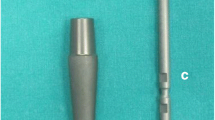Abstract
We conducted a prospective study of the clinical and radiographic variables related to the survival of 114 cementless resurfacing double-cup hip replacements (RHR) with a mean follow-up of 9 (range: 1–16) years. Three patients died, and 22 were unavailable for the final review in 2003. Sixty-one RHRs had to be revised to a total hip replacement. Failure analysis of these revised RHRs showed femoral head and neck resorption under the prosthesis in 33, acetabular protrusion in seven, both femoral and acetabular resorption in 14 and a femoral-neck fracture in three. One hip had dislocated, and there were three hips with unexplained pain. The Kaplan–Meier 5-year mean survival was 92%, the 10-year survival was 47% (95% CI 37–57%) and the 15-year survival was 30% (95% CI 20–40%). Pre-operative joint destruction (grade 1), a high degree of radiological osteoporosis, a body mass index >25 and prosthesis mismatch were significantly related to failure of the RHR. We believe that in young, non-obese patients with pre-operative radiological central destruction but without severe proximal femoral osteoporosis, a resurfacing arthroplasty may have some value. Our failures were mainly due to femoral resorption under the prosthetic femoral component.
Résumé
Nous avons conduit une évaluation rétrospective des variables cliniques et radiographiques qui déterminent la survie de 114 resurfaçages de la hanche par une double cupule sans ciment (RHR) avec un suivi moyen de 9 (1–16) ans. Trois malades sont morts et 22 étaient perdus de vue au dernier examen en 2003. Soixante et un RHR ont été révisés pour faire une prothèse totale. L’analyse des échecs montre une résorption de la tête et du col dans 33 cas; une protrusion acétabulaire dans 7 cas; une résorption fémorale et acétabulaire dans 14 cas; une fracture du col fémoral dans 3 cas. Il y avait une hanche avec luxation et trois hanches avec des douleurs inexpliquées. La survie moyenne (Kaplan–Meier) à 5 ans était 92%; la survie à 10 ans était 47% (95% CI 37–57%), la survie à 15 ans 30% (95% CI 20–40%). La destruction articulaire préopératoire de grade 1, le haut degré d’ostéoporose radiologique, l’index de masse corporelle >25, et la disparité de la prothèse avec le col fémoral sont des facteurs significatifs de l’échec du RHR. Chez des jeunes patients non-obèses, avec destruction centrale radiologique et sans sévère ostéoporose fémorale proximale, le resurfaçage peut avoir de la valeur. La mode d’échec était principalement la résorption fémorale en dessous du composant fémoral prothétique.




Similar content being viewed by others
References
Amstutz HC, Beaule PE, Dorey FJ, Le Duff MJ, Campbell PA, Gruen TA (2004) Metal-on-metal hybrid surface arthroplasty: two to six-year follow-up study. J Bone Joint Surg Am 86:28–39
Amstutz HC, Grigoris P, Safran MR et al (1994) Precision fit surface hemiarthroplasty for femoral head osteonecrosis. J Bone Joint Surg Br 76:423–427
Bachiller FG, Caballer AP, Portal LF (2002) Avascular necrosis of the femoral head after femoral neck fracture. Clin Orthop 399:87–109
Beaulé PE, Schmalzreid TP, Campbell P, Dorey F, Amstutz HC (2001) Duration of symptoms and outcomes of hemisurfacing for hip osteonecrosis. Clin Orthop 385:104–117
Brazier JE, Harper R, Jones NMB et al (1992) Validating the SF-36 health survey questionnaire: a new outcome measure for primary care. BMJ 305:160–164
Cotella L, Railton GT, Nunn D, Freeman MA, Revell PA (1990) ICLH double-cup arthroplasty, 1980–1987. J Arthroplasty 5:349–57
Daniel J, Pynsent PB, McMinn DJW (2004) Metal-on-metal resurfacing of the hip in patients under age of 55 years with osteoarthritis. J Bone Surg Br 86:177–184
Engh CA, Bobyn JD, Mattew JG II (1984) Biologic fixation of a modified Moore prosthesis. Evaluation of early clinical results. In Welsh RB (ed) The Hip. Proceedings of the Twelfth Open Scientific Meeting of the Hip Society 1984. C.V. Mosby Corp., pp 95–110
Ficat RP (1985) Idiopathic bone necrosis of the femoral head: early diagnosis and treatment. J Bone Joint Surg Br 67:3–10
Fornasier VL, Goodman SB, Protzner K, Kamel M, Song Y, Shojaci A (2004) The role of *implant* alignment on stability and particles on periprosthetic osteolysis—A rabbit model of *implant* failure. J Biomed Mater Res 70B:179–186
Howie DW, Campbell D, McGee M, Cornish BL (1990) Wagner resurfacing hip arthroplasty. The results of one hundred consecutive arthroplasties after eight to ten years. J Bone Joint Surg Am 72:708–714
Hungerford MW, Mont MA, Scott R, Fiore C, Hungerford DS, Krackow KA (1998) Surface replacement hemiarthroplasty for the treatment of osteonecrosis of the femoral head. J Bone Joint Surg Am 80:1656–1664
Larsen A, Dale K, Eck M (1977) Radiographic evaluation of rheumatoid arthritis and related conditions by standard reference films. Acta Radiol 18:481–491
Lieberman JR, Berry DJ, Mont MA, Aaron RK, Callaghan JJ, Rayadhyaksha A, Uraniak JR (2003) Osteonecrosis of the hip: management in the twenty-first century. Instr Course Lect 52:337–355
Mont MA, Rajadhyaksha AD, Hungerford DS (2001) Outcomes of limited femoral resurfacing arthroplasty compared with total hip for osteonecrosis of the femoral head. J Arthroplasty 16(8 suppl 1):134–139
Steinberg DR, Steinberg ME (2000) The early history of arthroplasty in the United States. Clin Orthop 374:55–89
Van Raaij JJAM (1995) Uncemented resurfacing hip arthroplasty. Clinical studies and failure analysis. Thesis, University of Leiden 1995
Van Raaij JJAM, Rozing PM (1993) The uncemented Gerard bipolar doublecup arthroplasty of the hip. A five- to 11-year follow-up study. Clin Orthop 294:123–130
Willems WJ, Obermann WR, Rozing PM (1988) Radiology in Gerard uncemented double cup arthroplasty. J Med Imaging 2:267–275
Wrobleski RG, Charnley J (1982) Radiographic morphology of the osteoarthritic hip. J Bone Joint Surg Br 64:746–751
Author information
Authors and Affiliations
Corresponding author
Rights and permissions
About this article
Cite this article
Duijsens, AW.H.B., Keizer, S., Vliet-Vlieland, T. et al. Resurfacing hip prostheses revisited. International Orthopaedics (SICOT) 29, 224–228 (2005). https://doi.org/10.1007/s00264-005-0652-8
Received:
Accepted:
Published:
Issue Date:
DOI: https://doi.org/10.1007/s00264-005-0652-8




